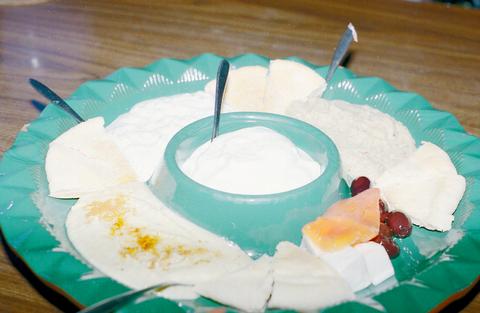As the only Greek restaurant in town, you can rest assured that a meal at Mykonos Taverna will be a special occasion. Owner Mike Waldorf has gone to great lengths to bring the authentic Greek taverna experience to Taiwan, and thankfully the greatest emphasis in doing so was placed on the food.
The flavors are of the Greek island regional variety, which is not to be confused with continental Athenian cuisine. Discriminating palates will be able to tell the difference, with the sparse use of spices and liberal doses of olive oil, and Waldorf proudly tells of the tears his food brought to the eyes of a homesick Greek salesman.
If the effect on Greek visitors, including singer Nana Mouskouri a few months ago, is powerful enough to recall "mama's cooking," it is because the recipes have not been tampered with to suit local taste buds. Mykonos serves the real thing and it is delicious.

PHOTO: MAX WOODWORTH
Begin a meal with a selection of the house's homemade classic mezed, or appetizers, including hummos, tzatziki, eggplant dip, Greek yogurt and feta cheese. The tzatziki is especially zesty, packed with loads of diced cucumber and garlic, and the yogurt is a direct descendent of the original yogurt culture used when the restaurant opened nine years ago. Try them individually or as a combination platter (NT$400). For another Greek classic, try the tiropita (NT$240), a sort of cheese pie with a wonderfully flaky crust and soft salty cheese. A variety of this treat is made with spinach, and is called the spanakopita (NT$250).
Make no mistake, Greek food tends to be on the heavy side, and Mykonos does not hold back in its use of cheese and olive oil. This is especially true of the main courses. The moussaka is prepared with exquisite lamb meat, a thick layer of beschemel, aubergine and plenty of olive oil and fresh oregano and could serve as an entire meal in itself. Only slightly lighter is the vegetarian moussaka. Meat lovers should try the stifado (NT$490), a dish of braised beef marinated for three days in red wine and onions and served with saffron rice. Another choice would be the souvlaki (NT$240), or barbecued lamb on a stick topped with the house tzatziki.
Mykonos is the type of place that diners will feel compelled to linger over a long meal. The murals of Greek island tourist sites, the breezy interior thanks to open terrace doors and the food can lull one into the Mediterranean rhythm.

In the next few months tough decisions will need to be made by the Taiwan People’s Party (TPP) and their pan-blue allies in the Chinese Nationalist Party (KMT). It will reveal just how real their alliance is with actual power at stake. Party founder Ko Wen-je (柯文哲) faced these tough questions, which we explored in part one of this series, “Ko Wen-je, the KMT’s prickly ally,” (Aug. 16, page 12). Ko was open to cooperation, but on his terms. He openly fretted about being “swallowed up” by the KMT, and was keenly aware of the experience of the People’s First Party

Aug. 25 to Aug. 31 Although Mr. Lin (林) had been married to his Japanese wife for a decade, their union was never legally recognized — and even their daughter was officially deemed illegitimate. During the first half of Japanese rule in Taiwan, only marriages between Japanese men and Taiwanese women were valid, unless the Taiwanese husband formally joined a Japanese household. In 1920, Lin took his frustrations directly to the Ministry of Home Affairs: “Since Japan took possession of Taiwan, we have obeyed the government’s directives and committed ourselves to breaking old Qing-era customs. Yet ... our marriages remain unrecognized,

Not long into Mistress Dispeller, a quietly jaw-dropping new documentary from director Elizabeth Lo, the film’s eponymous character lays out her thesis for ridding marriages of troublesome extra lovers. “When someone becomes a mistress,” she says, “it’s because they feel they don’t deserve complete love. She’s the one who needs our help the most.” Wang Zhenxi, a mistress dispeller based in north-central China’s Henan province, is one of a growing number of self-styled professionals who earn a living by intervening in people’s marriages — to “dispel” them of intruders. “I was looking for a love story set in China,” says Lo,

During the Metal Ages, prior to the arrival of the Dutch and Chinese, a great shift took place in indigenous material culture. Glass and agate beads, introduced after 400BC, completely replaced Taiwanese nephrite (jade) as the ornamental materials of choice, anthropologist Liu Jiun-Yu (劉俊昱) of the University of Washington wrote in a 2023 article. He added of the island’s modern indigenous peoples: “They are the descendants of prehistoric Formosans but have no nephrite-using cultures.” Moderns squint at that dynamic era of trade and cultural change through the mutually supporting lenses of later settler-colonialism and imperial power, which treated the indigenous as